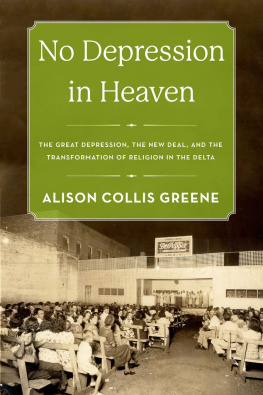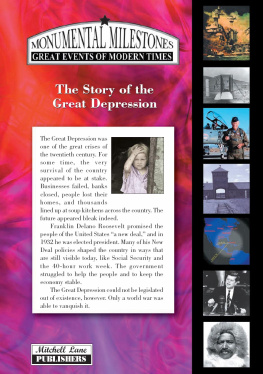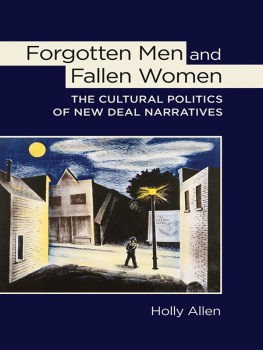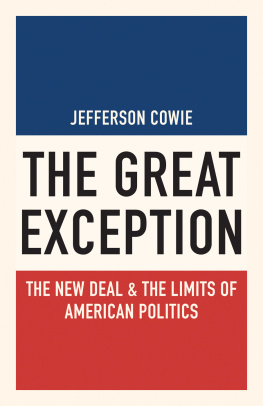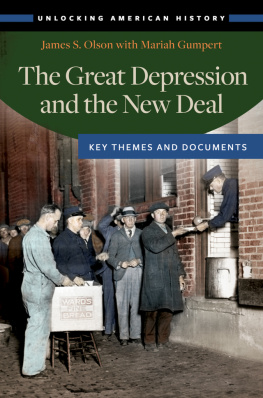Toward a New Deal in Baltimore
Publication of this work was made possible in part by a grant from the Division of Research Programs of the National Endowment for the Humanities, an independent federal agency which supports the study of such fields as history, philosophy, literature, and languages.
1988
The University of North Carolina Press
All rights reserved
Manufactured in the United States of America
The paper in this book meets the guidelines for permanence and durability of the Committee on Production Guidelines for Book Longevity of the Council on Library Resources.
92 91 90 89 88 5 4 3 2 1
Library of Congress Cataloging-in-Publication Data
Argersinger, Jo Ann E.
Toward a New Deal in Baltimore: people and government in the Great Depression / by Jo Ann E. Argersinger.
p. cm.
Revision of thesis (Ph.D.)George Washington University, 1980.
Bibliography: p.
Includes index.
ISBN 0-8078-5724-6 (alk. paper)
1. Baltimore (Md.)Politics and government. 2. Baltimore (Md.)
Social conditions. 3. Baltimore (Md.)Economic conditions.
4. New Deal, 19331939MarylandBaltimore. 5. Depressions1929
United States. I. Title.
F189.B157A74 1988
975.26042dcl9
87-21767
CIP
FOR PETER
Contents
Illustrations
The unemployed waiting for WPA work assignments
The citys WPA sewing project for black women
One of Baltimores WPA sewing rooms for white women
Baltimores WPA domestic training class for black women
Howard Street WPA pick-and-shovel project for black men
Houses to be razed and residents to be relocated in Baltimores first effort at slum clearance
The cleared site for Baltimores first public housing project
Residents inside their new Poe apartment
The Hunger March protest meeting
Agitation by the PUL for assistance to the unemployed
Baltimore Federation of Labor president Joseph McCurdy opens a BFL-sponsored exhibit entitled Labor in Art
Cab drivers attempt to unionize under the banner Roosevelt Said Organize
Arrest of Harry Cohen in the citys cab strike
Seamen receive their midday soup during maritime strike
Maritime workers from a number of unions joined together in the National Maritime Union
Democratic mayor Howard Jackson votes in the municipal elections of 1939
Acknowledgments
During my years of work on this project, I have acquired a number of debts, which, upon reflection, serve as a pleasant reminder of the generous assistance and encouragement I received. My oldest debt is to Joseph L. Arnold, who provided direction for my vague interests in voluntarism and the Great Depression. I am fortunate to be able still to profit from his advice and support, now as a colleague. I am particularly indebted to Leo P. Ribuffo, who guided the research as a dissertation. My work has benefited from his unusual sensibilities, probing criticisms, and skillful editing. His irreverence offered a healthy antidote to the seriousness with which I approached my work as a graduate student.
A number of friends and colleagues offered advice and support throughout the various stages of this manuscript. Peter P. Hill, James O. Horton, Linda Lear, Lonna Malmsheimer, and Kathy L. Peiss made the process more stimulating and enjoyable, and for that I am grateful. Charles H. Trout read and commented on different versions of this study. His effortsmarked by skill and precisionwere instrumental in my revisions and his own work served as a model of scholarship and intellectual clarity. I am also indebted to Richard Lowitt for sharing his criticisms and insights; my work benefited greatly from his careful reading. Finally, Otis L. Graham, Jr., and his NEH Summer Seminar for College Teachers in 1986 stimulated my thinking and offered many useful suggestions.
At the University of North Carolina Press, Lewis Bateman merits high praise for his encouragement and guidance. Ron Maner assisted me as my study became a book; he was always gracious and generous with his time and support. And Julia A. McVaugh demonstrated the value of a fine copyeditor.
Librarians and archivists at a number of institutions offered invaluable assistance. The staff at the National Archives was especially helpful, as were those at the Franklin D. Roosevelt Library in Hyde Park, the Southern Historical Collection at the University of North Carolina, the Martin P. Catherwood Library of the New York State School of Industrial and Labor Relations at Cornell University, and the Baltimore City Archives. I received important photographic assistance from the library of The Sun in Baltimore, where Fred Rasmussen deserves special mention for his efforts. I also wish to thank the Maryland Room of the University of Maryland College Park and the Special Collections Room of the Albin O. Kuhn Library of the University of Maryland Baltimore County for use of their photographic archives.
I am also grateful for typing grants from Dickinson College and the University of Maryland Baltimore County, which provided necessary assistance at different stages of the manuscript.
Carol M. Warner expertly typed the manuscript, while simultaneously struggling with the peculiarities of the Department of Historys new software and personal computer. She was joined in that valiant effort by Linda M. Hatmaker. I appreciate their persistence and professionalism.
I am most indebted to my family, whose support has been unfailing. My parents, Margaret L. Eady and Buford C. Eady, have encouraged me at every step. I also deeply appreciate the kindness and support provided by Marjorie H. Argersinger and William J. Argersinger, Jr. Other members of my family have tolerated long discussions of the New Deal and have feigned interest to a remarkable degree. But no one has done as much for me or my work as my husband, friend, and colleague, Peter H. Argersinger. He has generously shared his talents as a historian and editor. And it is to him that I dedicate this book with love and appreciation.
Introduction
For years historians have argued that a fuller understanding of the New Deal requires more systematic study of the 1930s at the state and local levels. In 1969, James T. Patterson underscored that need in The New Deal and the States and encouraged other scholars to examine the Roosevelt record in specific states and cities.
Much of this new work focuses on the role of the New Deal in meeting the problems and needs created by the Great Depression. It attempts to explain how people responded to a long depression and to a much shorter New Deal that ultimately failed to solve the problem of unemployment. It analyzes the effects of Franklin D. Roosevelt and the New Deal on politics, labor, and the unemployed. And, specifically, these studies evaluate the success of the New Deal, asking to what extent national administrators, state legislators, and municipal officials could have done more for relief and reform. With few exceptions, these works minimize the effects of the New Deal on the society and politics of the 1930s. John Braeman, Robert Bremner, and David Brody noted this when they wrote: Paradoxically the result of this new interest has been further to downgrade the significance of the New Deal as an instrument of fundamental changes in American life and society.
No longer, however, is the primary issue one of revolution versus reform but, more appropriately, of change versus stability. By examining local prerogatives, social practices, and political traditions, these newer studies conclude that neither the New Deals policies nor its programs were fully adopted in states and cities across the nation. In Ohio, for example, traditional politics and urban-rural divisions kept that state from creating a workable federal-state partnership and from providing its unemployed with adequate assistance. Strong states-rights sentiments also curbed enthusiasm for the New Deal, whereas such states as Virginia found that the economic goals of the New Deal programs were substantially out of harmony with [its] needs. Other states simply refused to pass enabling legislation in an attempt to preclude participation in federal programs. Kentucky followed that course of action, prompting Washington to intervene, and Colorado cooperated only after bitter threats and an actual suspension of federal funds.


